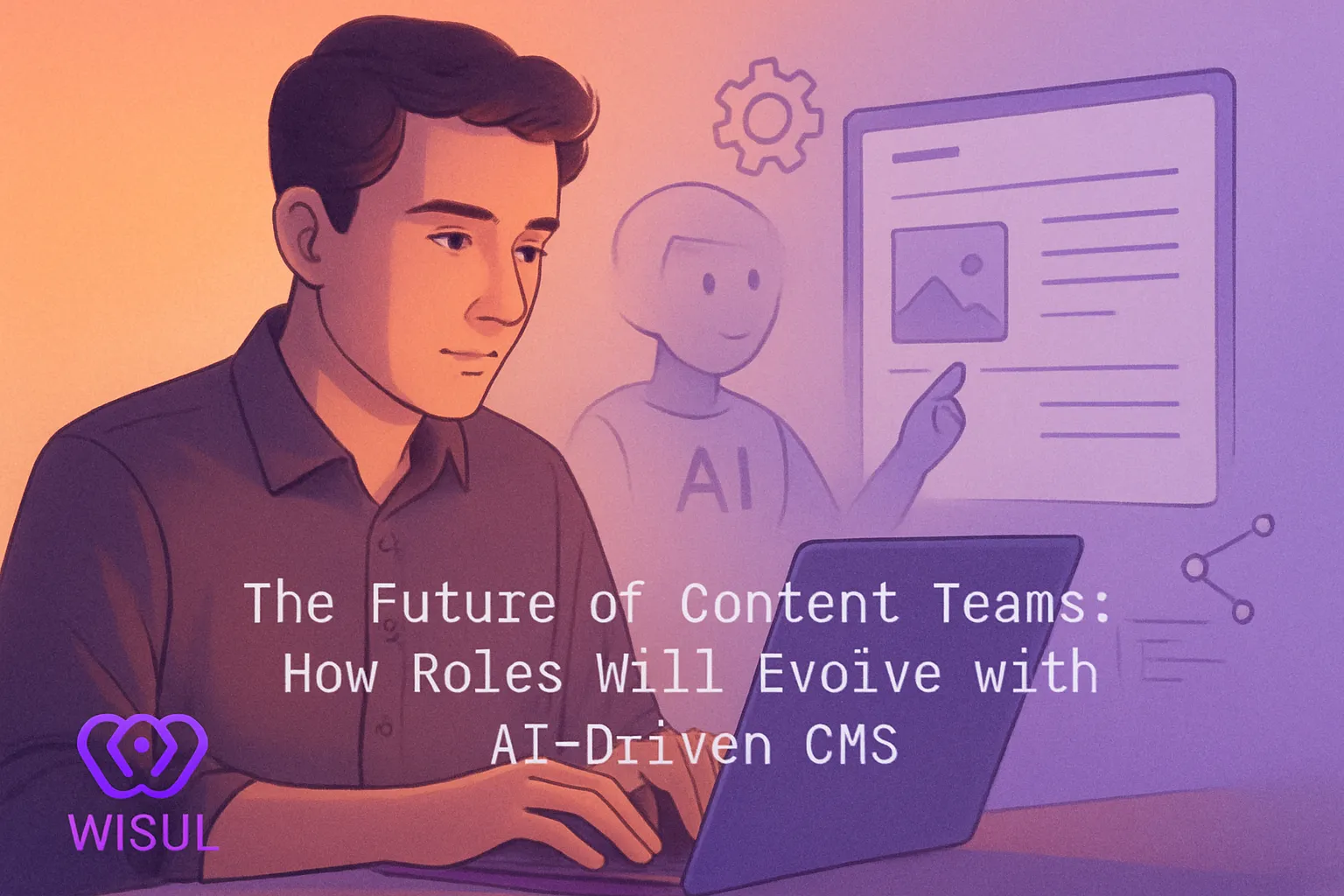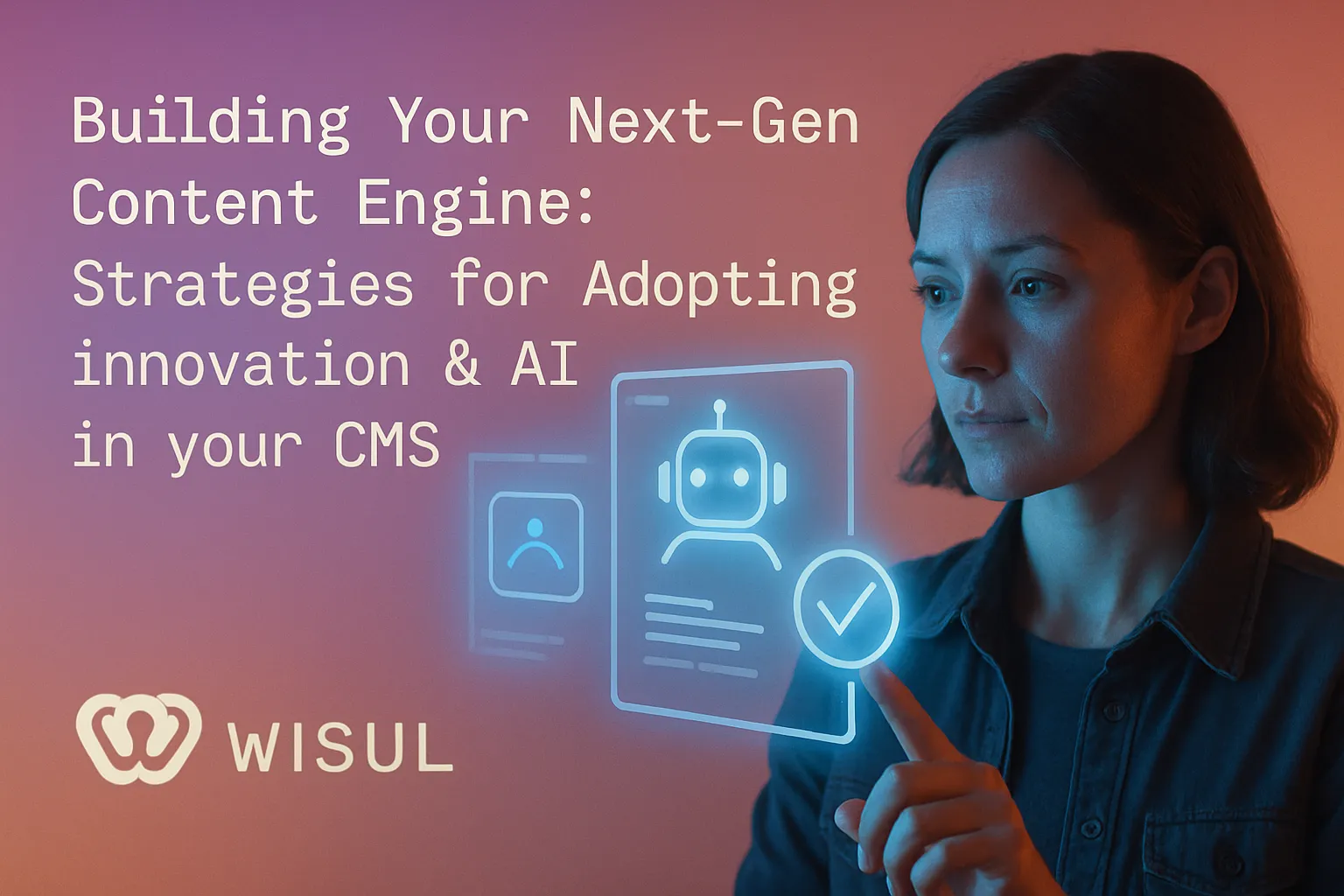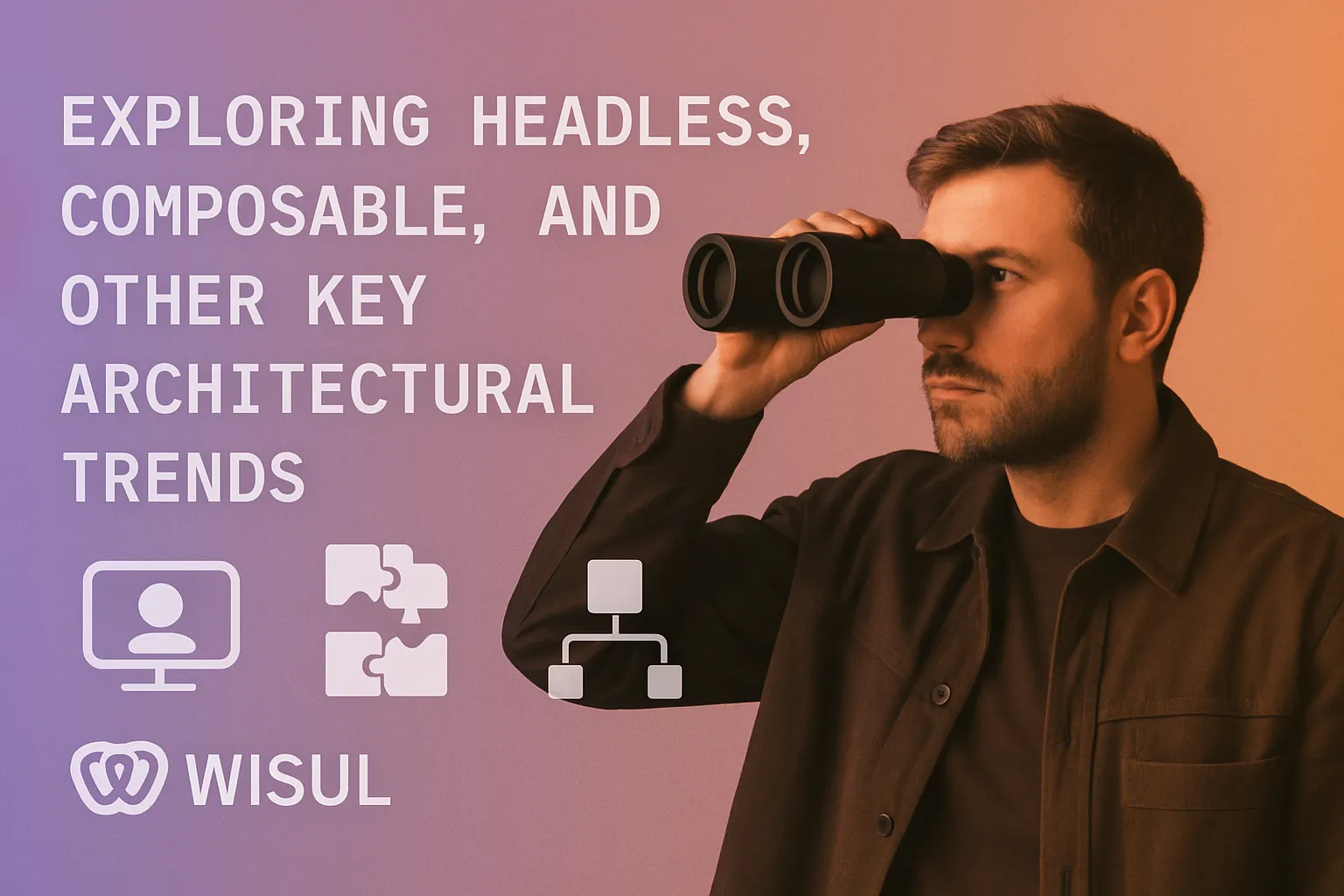- Key Takeaways
- The New Content Team Blueprint
- How AI-Driven CMS Changes Workflows
- Shifting from Creation to Curation
- What New Skills Matter Most
- Measuring Success Beyond Pageviews
- The Human-Centric Future
- Conclusion
- Frequently Asked Questions
- What is the new content team blueprint?
- How does an AI-driven CMS change content workflows?
- Why are content teams shifting from creation to curation?
- Which new skills are most important for content teams?
- How should content teams measure success beyond pageviews?
- Will AI replace humans in content teams?
- What is meant by a human-centric future for content teams?
Key Takeaways
- Future content team structure includes new roles like prompt engineers and AI ethicists, alongside traditional positions, to navigate the new challenges of AI-powered content creation.
- Collaboration with specialists, technologists and human editors is necessary to refine processes, and keep both efficiency and accountability in globally distributed teams.
- AI-powered content management systems optimize workflows by automating tedious tasks and improving team coordination, enabling experts to concentrate on innovative and strategic activities that provide higher impact.
- Winning content teams in the AI age need ongoing training in AI, cutting-edge data analytics and flexibility to stay relevant and competitive against fast changing trends across the globe.
- We measure content success with a more expansive set of engagement and loyalty metrics — not just pageviews, but how users are engaging with it, the quality of conversion and long-term relationship building.
- Human ingenuity and ethical direction still at the forefront, necessitating a trade-off between harnessing AI breakthroughs and maintaining the unique perspectives and personal flair that connect with audiences across the globe.
The future of content teams means more remote staff, more aggressive use of data, and new technologies helping accelerate the work process. Teams now have to learn how to blend skills in writing, design, and data.
Defined roles eliminate waste. To demonstrate how teams can transform, this post deconstructs practical trends and actions for teams to remain nimble and satisfy emerging demands in content labor.
The New Content Team Blueprint
Content teams are evolving at warp speed, fueled by AI, emerging roles, and competitive pressure. As a growing number of teams embrace AI-first work, the old habits and benchmarks no longer apply. Research and creation take the most time, and 65% teams want AI to assist here.
To keep pace, teams need to fill skill gaps—through hiring or training—while remaining committed to quality, originality, and earning reader trust. Investments in AI tools are growing, but so are the challenges: keeping control over quality, upskilling, working within budgets, and overcoming resistance to change.
The following roles are key for the new content team structure:
Prompt Engineer: Designs and refines AI prompts, making sure content from AI tools fits audience needs and brand tone.
AI Ethicist: Checks if AI use follows ethical and legal rules, protecting privacy and building trust.
Content Strategist: Sets direction using AI insights, keeps content tied to business goals, and adapts using real-time data.
Data Analyst: Digs into data, tracks performance, and translates insights for the team to use.
Human Editor: Reviews AI output for clarity, accuracy, and adds the creative touch only people bring.
1. The Prompt Engineer
This position requires expertise in prompt engineering, employing concise, carefully-crafted prompts to extract top AI responses. A prompt engineer collaborates with content creators to mold prompts, adjust AI parameters, and establish feedback loops, enabling the team to continuously refine content quality.
Say a prompt engineer teams up with a writer to develop a prompt that has an AI simplify complicated technical information to laypeople, then analyzes the outcomes and adjusts the process for optimal lucidity.
2. The AI Ethicist
AI ethicists have a growing job as AI turns to core to content. They monitor the ethical aspect, ensuring the team’s AI deployment is compliant and equitable. They test for language model bias, ensure personal data is secure and train the team on the importance of transparency.
When squads employ AI to draft medical guidelines or investment tips, ethicists come aboard to steer, ensuring material remains credible. They even write responsible AI use guidelines, assisting teams in steering clear of mistakes.
3. The Content Strategist
A strategist plans with AI-based insights, so content serves both user needs and business objectives. They leverage analytics to identify what’s working and what isn’t, then modify the schedule to align with trends or feedback.
For example, if predictive analytics indicate readers want video rather than text this quarter, the strategist redirects the team’s attention. They align the team’s objectives with the big picture—be it increasing engagement, expanding a subscriber base, or establishing credibility in new spaces.
4. The Data Analyst
The analyst pows through big data, identifying patterns and laying out the team actionable experiments to attempt. They monitor content performance, analyze engagement, and identify hot topics.
They build reports that show what’s working. They help the team make smarter choices. They keep the team’s work on target.
How AI-Driven CMS Changes Workflows
They’re not merely file storage systems; they perform activities that were time-consuming in the past, such as sifting through articles or tagging photos. For instance, AI CMS can scan text, identify key points, and even generate short blurbs. This allows writers to focus their time on big ideas or new campaigns, rather than tedious tasks in the content creation process.
AI tools are essential for content marketing teams as they identify opportunities to optimize for SEO as soon as a draft is completed. They scan for keywords, check links, and point out what to fix, enabling marketing teams to push out content that gets seen by more people. Real-time feedback ensures that modifications can be immediate, rather than post delay, which is crucial for effective content marketing efforts.
For images, AI can identify the subjects in a photograph and label it quickly. This makes it easy to find the perfect image or remain on brand. Content design teams now collaborate more closely as everyone can see the same AI insights, boosting productivity and efficiency.
A designer, a writer, and an editor can all view the same information and understand what works. AI can even recommend new topics or formats if a team is stumped. Tips are generated by viewing what users read or view, ensuring that content strategies remain current and align with the audience’s interests.
With AI, businesses can serve each reader content that suits them better. The system observes human behavior on the site and adjusts the user experience. It can scan for bad or risky content and flag it so teams can react quickly, enhancing their content marketing strategy.
They speed work, yet teams need to acquire new skills and become comfortable working alongside intelligent tools. Implementing AI requires workflows to adapt if teams want to extract the maximum value from AI and keep pace with rapidly evolving content marketing trends.
Shifting from Creation to Curation

Content teams used to invest the majority of their time in creation, but AI and the digital content tsunami has shifted the value curve. Today curation—discovering, organizing and sharing the best content—assists both teams and readers cope with information overload.
The table below shows how these two strategies differ:
Aspect | Creation | Curation |
|---|---|---|
Main Task | Make new content | Gather and sort existing content |
Skill Set | Writing, design, production | Research, evaluation, organization |
Tools | CMS, design software | AI curation, search, analytics |
Value | Fresh voice, originality | Context, relevance, expert insight |
Output | Articles, videos, podcasts | Playlists, summaries, resource hubs |
AI is front and center now. From natural language processing to trend tracking, these tools have been designed to help teams identify what people care about and what’s rising. That is less guesswork, more serving real audience needs.
For instance, AI can expose a health squad to what wellness trends are worth reporting or alert new money subjects for more digging. Instead of always creating new work, teams can now increase their value by curating what’s already there.
That might involve refreshing guides, adding new links or ensuring that older articles address current queries. Such work frequently provides readers with richer, more practical material than beginning from scratch.
It’s crucial to construct curation mechanisms that align with the audience’s desires and requirements. Good systems combine human judgment and AI sorting, so readers get content that is both relevant and well curated.
These systems enable users to discover inspiration, identify emerging ideas, and hear from trusted experts — not sift through bottomless results. Visual curation tools, for instance, allow you to discover leading photographers or designers in seconds, cutting down research time and inspiring new projects.
What New Skills Matter Most

Content teams need different skills to grow and lead in the AI era. The ascent of digital tools and global workspaces requires teams to develop new strengths, human and technical. The skills blend below will assist groups to make clever selections, remain in advance as well as function well in a quick-changing world.
- AI literacy and tool use
- Data analysis and interpretation
- Clear and flexible communication
- Emotional intelligence
- Adaptability and lifelong learning
- Creativity and idea generation
- Negotiation and relationship building
AI tools training is now a requirement. Teams that know how to use AI for research, writing, editing or content planning save time and spot trends early. That means understanding the fundamentals of machine learning, natural language processing, and prompt engineering.
If a team can leverage AI to automate the grunt work, they can spend more time being creative and differentiating.
Data skills matter more than ever. Teams that can read and sort and use data make better content. Relying on data allows your teams to recognize what is effective, what requires adjustment, and where new opportunities arise.
It’s not simply number-crunching—teams need to understand how to translate stats into decisions and feedback.
Good communication no longer just means writing or speaking well. It means teams need to share ideas across cultures, platforms and time zones. With the 4th industrial revolution, the ability to share ideas unambiguously is crucial for collaborating with partners around the world and scaling to new users.
Human skills are appreciating. Emotional intelligence enables leaders to lead teams through change, stress, and trust. Creativity gives teams the edge since AI can’t compete with human ideas and new perspectives.
Good negotiation and relationship skills help teams work with partners, solve problems, and build lasting ties.
Keeping up with new tools and trends isn’t just smart—it’s necessary. Teams have to view change as an opportunity to learn and grow, not a threat. This keeps teams primed for what’s next and receptive to new ways of working.
Measuring Success Beyond Pageviews
Content marketing teams are moving beyond simple pageview figures. Today, teams need richer ways to see how people use, value, and return to their work. Counting clicks or visits is no longer the real story. Instead, organizations rely on granular metrics to measure success, identify ai patterns, and pivot their marketing strategy for improved outcomes.
Engagement Metrics
- Time on Page and Session Duration
- Bounce Rate
- Scroll Depth
- Social Shares and Comments
- Number of Interactions per Session
- User Sentiment Scores
- Error or Violation Detection Rates in QA
- First-Attempt Success Rate
- Instruction Efficiency (average number of refinement cycles)
Teams look at user sentiment scores and feedback to understand how the audience feels about their content. It provides hints on what rocks and what sucks. Tools such as heatmaps and tracking scripts can indicate in what way people use each page or feature.
By measuring data across channels—web, social and mobile—teams discover what captures attention and what falls flat. Armed with engagement data, teams can alter formats, tinker with headlines, or refocus themes to increase satisfaction and prevent abandonment.
Conversion Quality
Metric | Method |
|---|---|
Conversion Rate | Analytics, CRM |
Lead-to-Sale Rate | Attribution Tracking |
A/B Test Improvement Rate | Split Testing |
Personalization Score | User Segmentation |
Conversion rates indicate how content contributes to meeting sales or lead goals. A/B testing allows teams to understand what headlines, calls to action, or formats are most effective.
Teams test how quickly users transition from initial click to completed action, gauging task instruction effectiveness and iteration rounds. Personalized content–localized pages or tailored guides, for example–can raise results. Analyzing these figures ensures teams focus their time on what returns.
Audience Loyalty
To cultivate dedicated audiences, staffs publish premium material on a fixed cadence. Responding to comments or social updates helps cultivate community and trust. Feedback, surveys, and cohort analysis reveal what makes users return or fugitive.
Loyalty programs, like early-access offers or digital badges, can transform casual viewers into repeat visitors and even advocates.
The Human-Centric Future

Content teams are at the intersection of human skills and machine power working in tandem. It’s human creativity and insight that crafts the stories and images and messages that resonate with people. Even as AI drafts or organizes data, it can’t replace the insight born of experience, empathy, or cultural context.
True trust and significance emanate from the human experience of seeing, touching, and hearing one another. In a world where technology fades into the woodwork, content teams have to be human-centric. That is, thinking not just about what’s automatable, but how to use technology to help people feel seen and understood.
AI might recommend headlines or visuals, for instance, but only humans can intuit when a story may insult or motivate a worldwide audience. Great teams let AI take care of tedium so they have more time to think strategically and creatively. Cooperation between humans and AI sets a quality bar, not just a speed bar.
When teams employ AI to seek patterns in reader tendencies, they’re able to tailor content to various requirements—rendering it more personal, functional and accessible. Personalization is more than a gimmick, it’s a way of respecting the reader’s time and interest. That headline creates relevant-feeling content, no matter where you live or what language you speak.
Content leaders need to put well-being and connection at the center. That is, the kind of decisions that prioritize humanity over pure profit. Trust-building content — whether by candid voice or in-person events, or even digital touchpoints — will shine.
The future is for those that leverage technology to uplift human-centric strengths, not substitute them.
Conclusion
Content teams are experiencing major transitions at the moment. Old models of constructing and distributing content drop off. New tools and skills rush in. AI accelerates work and creates room for new thinking. Teams require keen eyes for quality, not merely velocity. Skills such as data sense, smart editing and real teamwork differentiate strong teams. Good teams now look beyond clicks. They care less about superficial metrics and more about authentic influence and genuine value. The best teams remain human at the core, even with intelligent technology involved. To stay ahead, stay curious, try new solutions, and spread the word. Be part of the conversation–post your comments or your own successes. That’s how teams mold the future, and every voice contributes.
Frequently Asked Questions
What is the new content team blueprint?
The new blueprint centers on agile teams, collaboration, and technology integration, emphasizing the need for content marketing teams to adopt ai tools to boost productivity and enhance content production.
How does an AI-driven CMS change content workflows?
AI-powered CMS automates repetitive tasks, enhances content customization, and accelerates publication, allowing marketing teams to focus on content marketing efforts and intelligent productivity.
Why are content teams shifting from creation to curation?
With so much content online, marketing teams instead curate great and relevant information. This content marketing strategy is an elegant way to help audiences discover what counts the most, time-optimizing and trust-enhancing.
Which new skills are most important for content teams?
Data analysis, AI literacy, and adaptability are key for marketing teams. Effective collaboration and communication skills boost productivity in the evolving content marketing landscape.
How should content teams measure success beyond pageviews?
Teams ought to monitor engagement, audience expansion, and the effect of content marketing efforts. Metrics such as shares, comments, and conversion rates present a more complete profile of achievement.
Will AI replace humans in content teams?
No, AI adoption augments, not replaces humans. Human creativity, judgment, and empathy will continue to be necessary for implementing AI in producing resonant content.
What is meant by a human-centric future for content teams?
A human-centric future appreciates authenticity, trust, and audience needs. While implementing AI tools assists marketing teams, it’s still about providing true value and building authentic relationships.



